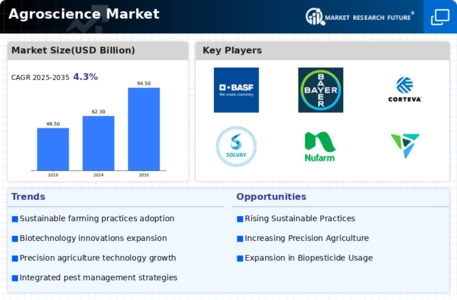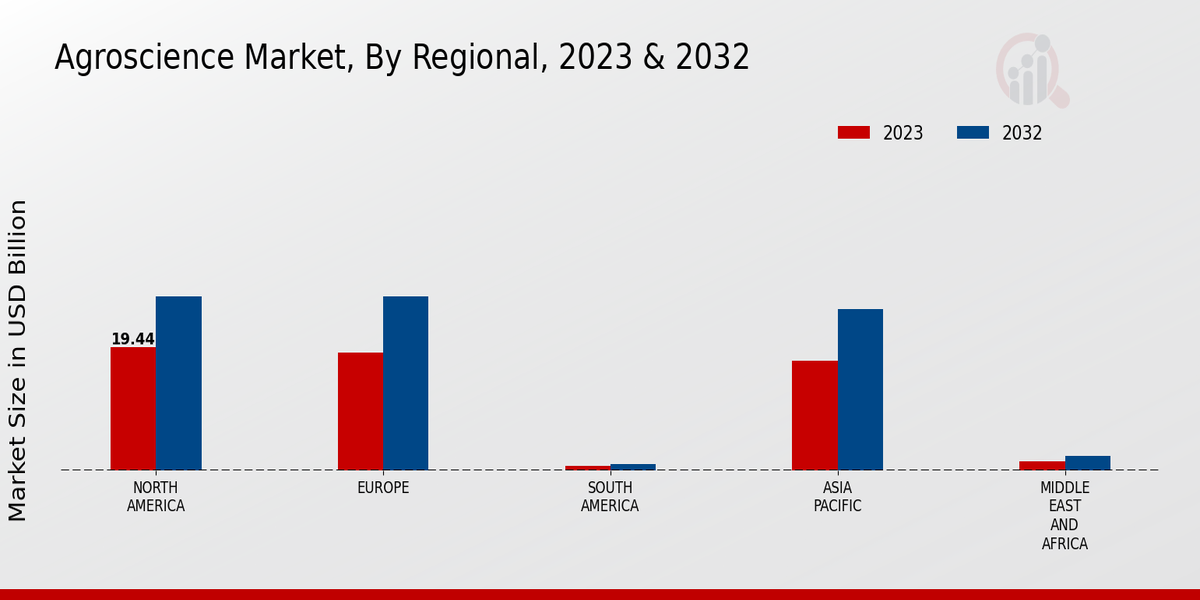Market Charts and Trends
Government Initiatives and Support
Government policies and initiatives play a crucial role in the Global Agroscience Market Industry. Many countries are implementing programs aimed at boosting agricultural productivity and sustainability. These initiatives often include subsidies for farmers adopting innovative technologies and practices. For example, various governments are promoting the use of genetically modified organisms (GMOs) to enhance crop resilience and yield. Such support not only encourages farmers to invest in agroscience but also fosters research and development in the sector. As a result, the market is likely to benefit from increased funding and resources, further driving growth in the Global Agroscience Market Industry.
Growing Interest in Organic Farming
The Global Agroscience Market Industry is witnessing a surge in interest towards organic farming, driven by consumer preferences for healthier and chemical-free food options. This trend is reflected in the increasing number of organic farms and the rising demand for organic inputs. As consumers become more health-conscious, the market for organic fertilizers and pest control solutions is expanding. This shift not only supports environmental sustainability but also aligns with the broader goals of food safety and quality. The growth in organic farming is expected to contribute positively to the overall market dynamics, reinforcing the importance of organic practices within the Global Agroscience Market Industry.
Rising Demand for Sustainable Agriculture
The Global Agroscience Market Industry experiences a notable shift towards sustainable agricultural practices. This trend is driven by increasing consumer awareness regarding environmental issues and the need for food security. As farmers adopt eco-friendly methods, the demand for biopesticides and biofertilizers rises. In 2024, the market is projected to reach 62.3 USD Billion, reflecting a growing inclination towards sustainable solutions. Governments worldwide are also incentivizing sustainable practices, further propelling market growth. This shift not only addresses environmental concerns but also enhances crop yields, thereby contributing to the overall growth of the Global Agroscience Market Industry.
Technological Advancements in Agroscience
Technological innovations play a pivotal role in shaping the Global Agroscience Market Industry. The integration of precision agriculture, biotechnology, and data analytics enhances productivity and efficiency in farming. For instance, the use of drones for crop monitoring and soil analysis allows farmers to make informed decisions, optimizing resource use. As these technologies become more accessible, the market is likely to witness significant growth. The anticipated CAGR of 3.86% from 2025 to 2035 indicates a robust future for the industry, driven by continuous advancements that improve crop management and yield. This technological evolution is essential for meeting the demands of a growing global population.
Increasing Global Population and Food Demand
The Global Agroscience Market Industry is significantly influenced by the rising global population, which is expected to reach approximately 9.7 billion by 2050. This demographic shift necessitates an increase in food production to meet the escalating demand. Consequently, agricultural inputs such as fertilizers, pesticides, and advanced seeds are in higher demand. The market's projected growth to 94.5 USD Billion by 2035 underscores the urgency of enhancing agricultural productivity. Governments and organizations are investing in research and development to innovate solutions that can sustainably increase food production. This growing need for food security is a primary driver of the Global Agroscience Market Industry.










